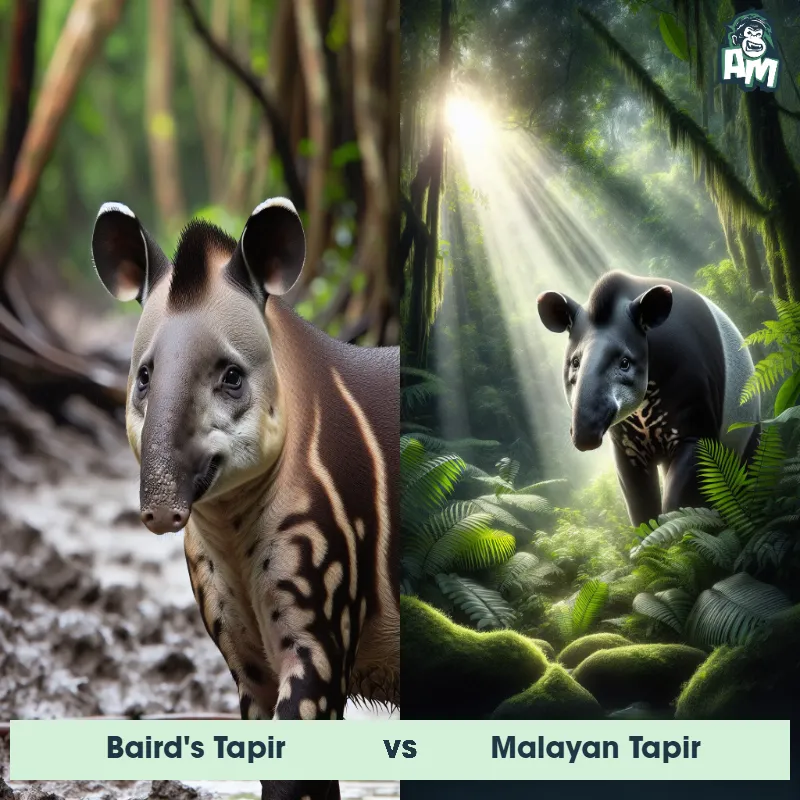The Baird's Tapir
The Baird's Tapir is a large, herbivorous mammal found in the forests, swamps, and grasslands of Central and South America. They have a stocky build with a rounded body and are the largest tapir species, weighing up to 600 kilograms and measuring up to 2 meters in length. Their coat is dark brown or black, and they have a distinctive elongated snout, called a proboscis, which is used for feeding and communication. Baird's Tapirs also have short, stubby tails and four-toed feet with hooved toes. They are primarily nocturnal animals and are known for their solitary and secretive nature.

| Baird's Tapir | |
|---|---|
| Size | Up to 1.8 meters (6 feet) in length |
| Weight | Up to 550 kilograms (1,210 pounds) |
| Speed | 30mph (48km/h) |
| Key Strength | Powerful bites and strong body |
| Biggest Weakness | Limited mobility and slow movement |
| Scientific Name | Tapirus bairdii |
| Family | Tapiridae |
| Habitat | Forests, swamps, and grasslands |
| Geography | Central America and northern parts of South America |
| Diet | Herbivorous - Feeds on fruits, leaves, and aquatic plants |
| Lifespan | 20 years - 30 years |

The Baird's Tapir
The Baird's Tapir is a large, herbivorous mammal found in the forests, swamps, and grasslands of Central and South America. They have a stocky build with a rounded body and are the largest tapir species, weighing up to 600 kilograms and measuring up to 2 meters in length. Their coat is dark brown or black, and they have a distinctive elongated snout, called a proboscis, which is used for feeding and communication. Baird's Tapirs also have short, stubby tails and four-toed feet with hooved toes. They are primarily nocturnal animals and are known for their solitary and secretive nature.
Fun Fact: Baird's Tapirs are excellent swimmers and can often be found submerged in water, where they use their long snouts as snorkels to breathe while remaining hidden from predators.
| Baird's Tapir | |
|---|---|
| Size | Up to 1.8 meters (6 feet) in length |
| Weight | Up to 550 kilograms (1,210 pounds) |
| Speed | 30mph (48km/h) |
| Key Strength | Powerful bites and strong body |
| Biggest Weakness | Limited mobility and slow movement |
| Scientific Name | Tapirus bairdii |
| Family | Tapiridae |
| Habitat | Forests, swamps, and grasslands |
| Geography | Central America and northern parts of South America |
| Diet | Herbivorous - Feeds on fruits, leaves, and aquatic plants |
| Lifespan | 20 years - 30 years |
Baird's Tapir Matchups
We use AI to simulate matchups between the Baird's Tapir and other animals. Our simulation considers size, strength, and natural predatory behaviors to determine the most likely outcome.

Can't find the Matchup you want?
Create Your Own MatchupBaird's Tapir: Diet, Predators, Aggression, and Defensive Behaviors
What do Baird's Tapirs eat?
Baird's Tapirs are herbivores, primarily feeding on leaves, fruits, and aquatic plants. They have a selective diet, preferring soft, succulent vegetation and fruits such as berries and palm nuts. They are known to forage both during the day and night, using their excellent sense of smell to locate food.
Do Baird's Tapirs have any predators?
Baird's Tapirs are large mammals that do not have many natural predators. However, they may face threats from jaguars, pumas, and occasionally large snakes like anacondas. Their well-developed sense of smell and acute hearing help them detect predators, allowing them to evade danger.
Are Baird's Tapirs aggressive?
Baird's Tapirs are generally shy and solitary animals, and they are not known to be aggressive towards humans or other animals. However, they can become defensive if they feel threatened or cornered, using their strong jaws and sharp teeth to defend themselves.
Do Baird's Tapirs fight?
Baird's Tapirs are not territorial animals, so conflicts between individuals are relatively rare. However, during the breeding season, male tapirs may compete for access to females by engaging in aggressive encounters. These fights typically involve vocalizations, charging, and biting.
How do Baird's Tapirs defend themselves?
When threatened, Baird's Tapirs rely on their camouflage, agility, and powerful bodies to escape predators. They can run at impressive speeds, swim well, and even dive underwater to evade danger. If cornered, tapirs may use their strong jaws and sharp teeth as a last resort for defense.
What is Baird's Tapirs' biggest weakness in a fight?
Despite their large size and robust build, Baird's Tapirs are vulnerable to attacks on their soft underbellies, necks, and limbs. Their thick skin provides some protection, but these areas are still susceptible to injuries in a fight. This vulnerability makes it crucial for tapirs to utilize their agility and speed to avoid confrontations whenever possible.
Fun Fact: Baird's Tapirs have a close relationship with jaguars. Research has shown that tapirs facilitate the movement of jaguars through their habitats by creating trails or paths in the forest. This mutually beneficial relationship benefits both species.
Fun Fact: The Baird's Tapir is an important seed disperser in its ecosystem. As they move through the forest, tapirs consume a variety of fruits, passing the seeds through their digestive system. These seeds are then dispersed in different locations, helping to maintain a diverse and healthy forest ecosystem.











